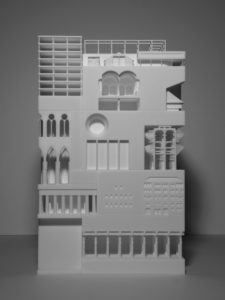 Architectural styles have changed over time, just as trends relating to almost anything change. To really follow the progress of architectural evolution, you’d have to look at a lot of buildings and examine how different elements shift into new styles, new methods of construction. Sometimes the shift can be dramatic, but if you line up an assortment of structures from the earliest days of architecture until now, you can see gradual progressions. That’s kind of what Fumio Matsumoto, a project professor at the University of Tokyo‘s University Museum, did, but he did it in a much more creative way than simply lining up models or pictures of buildings.
Architectural styles have changed over time, just as trends relating to almost anything change. To really follow the progress of architectural evolution, you’d have to look at a lot of buildings and examine how different elements shift into new styles, new methods of construction. Sometimes the shift can be dramatic, but if you line up an assortment of structures from the earliest days of architecture until now, you can see gradual progressions. That’s kind of what Fumio Matsumoto, a project professor at the University of Tokyo‘s University Museum, did, but he did it in a much more creative way than simply lining up models or pictures of buildings.
Matsumoto 3D printed a single model that contains pieces of 35 different famous buildings, going from the 18th century BC to 2005 and spanning a range of styles that gradually change over time. The model is in the shape of an elongated block and begins with the earliest elements at the bottom, moving upward through time and ending with the 21st century at the top. Called “Memories of Architecture,” it’s a compact look at how the way we build evolves and changes.
“While it is not a comprehensive overview of architectural history, it does illustrate some significant trends over time, such as the shift from massive to minute forms and from enclosed to open spaces,” said Matsumoto.
 The 3D printed model contains pieces from façades, interiors and exteriors, all 3D printed at 1:300 scale and slotted together in a way that allows them to stand clearly out from each other piece and yet to act as a coherent whole. “Memories of Architecture” does not look messy or chaotic, but flows together to form a building that, while eccentric, is extremely eye-catching. If it were reproduced at full scale, it would certainly be a fast tourist attraction.
The 3D printed model contains pieces from façades, interiors and exteriors, all 3D printed at 1:300 scale and slotted together in a way that allows them to stand clearly out from each other piece and yet to act as a coherent whole. “Memories of Architecture” does not look messy or chaotic, but flows together to form a building that, while eccentric, is extremely eye-catching. If it were reproduced at full scale, it would certainly be a fast tourist attraction.
Buildings represented in “Memories of Architecture” range from the Parthenon to the Pantheon, from the 18th-century BC Karnak Temple to the modern day Moriyama House. In addition to being a work of art, the 3D printed model is a puzzle as well, a challenge for architecture students and fans to see how many structures they can identify.
As Matsumoto said, you can indeed see the way architectural trends change over time – huge arches at the bottom gradually give way to toothpick-like structures and smooth façades at the top. It’s also interesting to see how some trends repeat, like rows of columns, although the style of the columns themselves change.
It would be impressive to see “Memories of Architecture” reproduced as a full-sized building – maybe a 3D printed one. Even at its current size, the model is impressive, serving as work of art, puzzle, educational aid, and monument to the field of architecture over the years. It’s well worth taking a close look at, and searching for the different works of architecture represented is a good way to study it closely. Take some time to test your architectural knowledge, and if you get stuck, you can find all of the answers here.
Discuss this and other 3D printing topics at 3DPrintBoard.com or share your thoughts below.
[Images: Fumio Matsumoto]
Subscribe to Our Email Newsletter
Stay up-to-date on all the latest news from the 3D printing industry and receive information and offers from third party vendors.
You May Also Like
Precision at the Microscale: UK Researchers Advance Medical Devices with BMF’s 3D Printing Tech
University of Nottingham researchers are using Boston Micro Fabrication‘s (BMF) 3D printing technology to develop medical devices that improve compatibility with human tissue. Funded by a UK grant, this project...
3D Printing Webinar and Event Roundup: April 21, 2024
It’s another busy week of webinars and events, starting with Hannover Messe in Germany and continuing with Metalcasting Congress, Chinaplas, TechBlick’s Innovation Festival, and more. Stratasys continues its advanced training...
3D Printing Webinar and Event Roundup: March 17, 2024
It’s another busy week of webinars and events, including SALMED 2024 and AM Forum in Berlin. Stratasys continues its in-person training and is offering two webinars, ASTM is holding a...
3D Printed Micro Antenna is 15% Smaller and 6X Lighter
Horizon Microtechnologies has achieved success in creating a high-frequency D-Band horn antenna through micro 3D printing. However, this achievement did not rely solely on 3D printing; it involved a combination...































